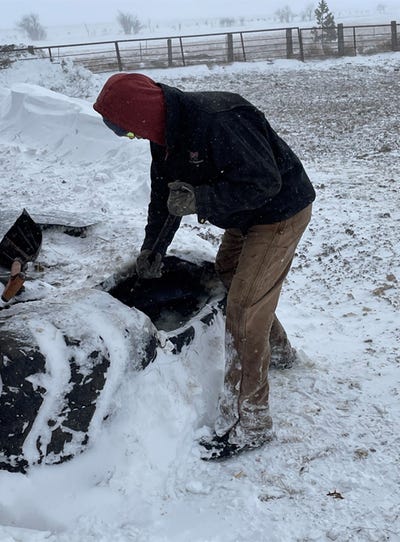
During a mid-April blizzard, parts of North and South Dakota were hit hard with snow anywhere from 5 to 50 inches. One ranching family, the Nordbys of North Dakota, worked diligently to protect their cows and calves.
“It’s a lot of snow and a lot of work, but we definitely needed the moisture,” says Hannah Nordby, who ranches with her parents, Donald and Sarah, and brothers Ty and Tate near Amidon, N.D. “We started off pre-blizzard by bringing the cows home and closer to shelter, and we’re right in the middle of our heavy part of calving. We brought them close to home and bedded down and put up some windbreaks, and put those that were heavy calving closest to the barn.”
Many ranchers experienced this blizzard in the height of their calving season, adding an extra layer of difficulty to an already challenging season. “I’ve seen a lot of ranchers getting really creative, making little calf shelters, windbreaks out of straw bales, things like that. If they don’t have the barn space, they just start from ground zero and build something up,” she says.
 CHALLENGES FACED: Ranchers across the region dealt with various challenges brought on by the extensive snowfall.
CHALLENGES FACED: Ranchers across the region dealt with various challenges brought on by the extensive snowfall.

One of their heaviest days of calving occurred during the height of the blizzard. “We had 16 calves in 12 hours, so they came hard,” Norby says. “We were out on the hour every hour checking for calves and bringing them into the barn to stay warm.”
The storm did allow for plenty of family bonding time, Nordby says. “It’s a blessing having all five of us here,” she says. “We check in shifts and sleep in shifts, and the coffee pot is always on and full.”
Multiple phases
When the snow ended, the next phase was still onerous. “Phase 1 is just getting everything through the storm, and then we’re onto Phase 2. We’re out pushing snow and making space, and then getting into the rest of the cleanup,” she says. “It won’t be warming up for a few days still, so we’ll be out checking frequently making sure the calves aren’t chilled, and then working to clean up the barn as we go.”
The Nordbys like many ranchers turned their entire barn into a warm, dry place for cows and calves. “We made the makeshift pens, and there isn’t a single spot in the barn we haven’t utilized,” she says.
After the blizzard and cleanup, maintaining the animals’ health now takes precedence. “I’m hoping we won’t have to be battling disease. But it is just in the back of my mind where we had them in a confined area, and it’s kind of sloppy and messy, so we’ll be on the lookout for that,” Nordby says. “Our cows, heifers and bulls are all mixed together now, so we’ll be getting some sorting done also.”
About the Author(s)
You May Also Like






